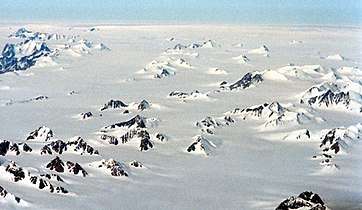Glacial survival hypothesis
According to the northern cryptic glacial refugial hypothesis (or glacial survival hypothesis), during the last ice age cold tolerant plant and animal species (e.g. Norway spruce and Norwegian lemmings) persisted in ice-free microrefugia north of the Alps in Europe.[1][2][3][4][5][6] The alternative hypothesis of no persistence and postglacial immigration of plants and animals from southern refugia in Europe (southern refugia paradigm)[7] is sometimes also called the tabula rasa hypothesis.[8]

Over the past plants and animals have persisted through long periods of climate change including several glacial and interglacial periods. There is a long-standing debate on what happened to the species that were inhabiting high-latitude regions during the Pleistocene ice age. Two main scenarios are usually considered. The first scenario proposes a total extinction of species within glaciated areas with survival events in peripheral refugia in the south and successive massive postglacial migration into empty areas (tabula rasa hypothesis).[8] The second scenario proposes long-term in situ survival within glaciated regions (glacial survival hypothesis), either in isolated northern ice-free micro-refugia at the edge of the ice sheet, or on exposed mountains not covered with ice within the ice sheet (nunatak hypothesis).
For boreal and cold-tolerant species the glacial survival hypothesis is credible, though controversial,[9][10][11] and a growing body of molecular data are now supporting it for both plant and animal species.[4][5][12][13] A number of recent studies have shown that several northern regions (above latitudes >45° N) have supported low-density boreal and temperate tree populations during the late-glacial or Early Holocene [e.g. North America, Eurasia, Alps, Scandinavia].[4][14][15][16]
In recent years several studies have combined lines of evidence coming from three major disciplines to infer the existence of past refugia: fossil records, species distribution models and molecular/phylogeographic surveys.[17] In this way, it should be possible to better describe complex migration routes followed by species and populations in and out of refugia through time and space.
References
- WILLIS, K; VANANDEL, T (December 2004). "Trees or no trees? The environments of central and eastern Europe during the Last Glaciation". Quaternary Science Reviews. 23 (23–24): 2369–2387. doi:10.1016/j.quascirev.2004.06.002. ISSN 0277-3791.
- Stewart, John R.; Lister, Adrian M. (November 2001). "Cryptic northern refugia and the origins of the modern biota". Trends in Ecology & Evolution. 16 (11): 608–613. doi:10.1016/s0169-5347(01)02338-2. ISSN 0169-5347.
- Willis, Katherine J.; Rudner, Edina; Sümegi, Pal (March 2000). "The Full-Glacial Forests of Central and Southeastern Europe". Quaternary Research. 53 (2): 203–213. doi:10.1006/qres.1999.2119. ISSN 0033-5894.
- Parducci, L.; Jorgensen, T.; Tollefsrud, M. M.; Elverland, E.; Alm, T.; Fontana, S. L.; Bennett, K. D.; Haile, J.; Matetovici, I.; Suyama, Y.; Edwards, M. E.; Andersen, K.; Rasmussen, M.; Boessenkool, S.; Coissac, E.; Brochmann, C.; Taberlet, P.; Houmark-Nielsen, M.; Larsen, N. K.; Orlando, L.; Gilbert, M. T. P.; Kjaer, K. H.; Alsos, I. G.; Willerslev, E. (1 March 2012). "Glacial Survival of Boreal Trees in Northern Scandinavia". Science. 335 (6072): 1083–1086. doi:10.1126/science.1216043. PMID 22383845.
- Fedorov, VB; Stenseth, NC (22 April 2001). "Glacial survival of the Norwegian lemming (Lemmus lemmus) in Scandinavia: inference from mitochondrial DNA variation". Proceedings: Biological Sciences. 268 (1469): 809–14. doi:10.1098/rspb.2001.1584. PMC 1088673. PMID 11345325.
- Kullman, L. (2002). "Boreal Tree Taxa in the Central Scandes during the Late-Glacial: Implications for Late-Quaternary Forest History". Journal of Biogeography. 29 (9): 1117–1124. doi:10.1046/j.1365-2699.2002.00743.x. JSTOR 827434.
- Tzedakis, P.C.; Emerson, B.C.; Hewitt, G.M. (December 2013). "Cryptic or mystic? Glacial tree refugia in northern Europe". Trends in Ecology & Evolution. 28 (12): 696–704. doi:10.1016/j.tree.2013.09.001. ISSN 0169-5347. PMID 24091207.
- Brochmann, C.; Gabrielsen, T. M.; Nordal, I.; Landvik, J. Y.; Elven, R. (August 2003). "Glacial Survival or tabula rasa? The History of North Atlantic Biota Revisited". Taxon. 52 (3): 417. doi:10.2307/3647444. JSTOR 3647444.
- Tzedakis, P.C.; Emerson, B.C.; Hewitt, G.M. (2013-12-01). "Cryptic or mystic? Glacial tree refugia in northern Europe". Trends in Ecology & Evolution. 28 (12): 696–704. doi:10.1016/j.tree.2013.09.001. ISSN 0169-5347. PMID 24091207.
- Birks, H. H.; Giesecke, T.; Hewitt, G. M.; Tzedakis, P. C.; Bakke, J.; Birks, H.J B. (2012-11-09). "Comment on "Glacial Survival of Boreal Trees in Northern Scandinavia"". Science. 338 (6108): 742. doi:10.1126/science.1225345. ISSN 0036-8075. PMID 23139314.
- Finsinger, W.; Schwörer, C.; Heiri, O.; Morales-Molino, C.; Ribolini, A.; Giesecke, T.; Haas, J. N.; Kaltenrieder, P.; Magyari, E. K. (2018-07-18). "Fire on ice and frozen trees? Inappropriate radiocarbon dating leads to unrealistic reconstructions" (PDF). New Phytologist. 222 (2): 657–662. doi:10.1111/nph.15354. ISSN 0028-646X. PMID 30019412.
- Westergaard, K. B.; Alsos, I. G.; Popp, M.; Engelskjøn, T.; Flatberg, K. I.; Brochmann, C. (2010-12-13). "Glacial survival may matter after all: nunatak signatures in the rare European populations of two west-arctic species". Molecular Ecology. 20 (2): 376–393. doi:10.1111/j.1365-294x.2010.04928.x. ISSN 0962-1083. PMID 21156004.
- Loehr, J.; Worley, K.; Grapputo, A.; Carey, J.; Veitch, A.; Coltman, D. W. (March 2006). "Evidence for cryptic glacial refugia from North American mountain sheep mitochondrial DNA". Journal of Evolutionary Biology. 19 (2): 419–430. CiteSeerX 10.1.1.574.4471. doi:10.1111/j.1420-9101.2005.01027.x. ISSN 1010-061X. PMID 16599918.
- Binney, H. A.; Willis, K. J.; Edwards, M. E.; Bhagwat, S. A.; Anderson, P. M.; Andreev, A. A.; Blaauw, M.; Damblon, F.; Haesaerts, P. (2009-11-01). "The distribution of late-Quaternary woody taxa in northern Eurasia: evidence from a new macrofossil database" (PDF). Quaternary Science Reviews. 28 (23–24): 2445–2464. doi:10.1016/j.quascirev.2009.04.016.
- McLachlan JS, Clark JS, Manos PS. 2005. Molecular indicators of tree migration capacity under rapid climate change. Ecology 86: 2088–2098.
- Carcaillet, C.; Blarquez, O. (2017-08-14). "Fire ecology of a tree glacial refugium on a nunatak with a view on Alpine glaciers". New Phytologist. 216 (4): 1281–1290. doi:10.1111/nph.14721. ISSN 0028-646X. PMID 28805959.
- Gavin, D. G.; Fitzpatrick, M. C.; Gugger, P. F.; Heath, K. D.; Rodríguez-Sánchez, F.; Dobrowski, S. Z.; Hampe, A.; Hu, F. S.; Ashcroft, M. B. (2014-07-16). "Climate refugia: joint inference from fossil records, species distribution models and phylogeography". New Phytologist. 204 (1): 37–54. doi:10.1111/nph.12929. ISSN 0028-646X. PMID 25039238.